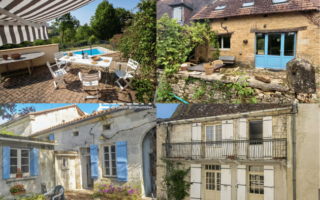What is taxe d’aménagement and do I have to pay it?

There may not be any up-front fees to pay when submitting a planning application in France but you will need to factor in the cost of various taxes, as Arthur Cutler explains
If you are planning to carry out work to your French property and your project creates ‘taxable space’ there will be various taxes to pay. Note here that living space is taxable space, and a garage is taxable space, though not living space. The taxes are collectively called taxes d’aménagement. Let’s look at these further and how the taxes arise and are calculated.
When do taxes d’aménagement become payable?
Taxes d’aménagement become payable when one or more of the following arise as a consequence of your projected works:
– The creation of additional living space (surface de plancher) – eg: new-build, extension, conversion of non-habitable space into habitable space (such as the conversion of a garage into an additional bedroom)
– The creation of additional non-living space – eg: construction of a garage, garden shed, greenhouse, summer kitchen, etc
– The installation of a swimming pool, whether covered or not, and whether in-ground or above-ground
– The creation of car parking spaces, whether covered or not – for example an open carport which creates an additional parking space, but also parking spaces which have no covering. Note that the construction of a carport requires planning permission, but does not give rise to taxes d’aménagement unless it creates additional parking spaces.
– Although the renovation of existing buildings may not on the face of it create additional taxable space, if the project includes the replacement of existing floors, or an increase in the number of floors within an existing building, then taxes will arise. For example, if the project is to convert an attached barn into extra living space, with the construction of a mezzanine level in the barn, then taxes will arise.
The definition of ‘creation of taxable space’ varies form planning officer to planning officer! Some will consider a barn conversion as exempt from taxes, while others may decide otherwise. The local tax office makes the final decisions on this, and you can request a meeting to discuss a project with regard to these taxes, or challenge them once you receive a demand. Subject to individual consideration, some projects may be excluded from these taxes, for example if a new dwelling is to be built and funded by an approved zero-rate loan.
_________________________________________________________________
Don’t miss…..
What is taxe d’habitation and do I have to pay it?
What is taxe foncière and do I have to pay it?
What is the flat tax in France and do I have to pay it?
_________________________________________________________________
Calculating taxable areas
Taxes are payable on the space created for each floor of a property which is ‘closed and covered’, calculated on the internal floor areas, ignoring any areas where the head-height is less than 1.8 m. Floor areas taken up by stairwells or lifts are also excluded. A three-storey dwelling for example, will potentially have three times the taxable space of a single-storey dwelling. A garage with a mezzanine storage area will be the total of the floor area of the garage, plus the mezzanine.
Calculation of taxes
For 2019, there is a base rate tax (valeur forfaitaire) of €753/m2. This applies for the vast majority of France, but some areas such have a higher base rate. The rate for Île-de-France, for example, is €854/m2. In principle this covers all additional taxable spaces created, though some authorities allow reductions in some cases for outbuildings (sheds, greenhouses, etc), and also if the project creates only a modest area of living space for a property used as a main dwelling.
The taxes are charged on two main elements: departmental share and communal share. The department in which your property is based charges a percentage of the tax, and the commune also charges (or has the right to charge, though some communes don’t actually charge it at all) a percentage of the tax. The percentages may vary from area to area and commune to commune, so it isn’t possible to give an accurate general indication of what the cost may be, but the mairie of the commune can provide precise details on request. Suffice to say that in ‘wealthier’ areas the taxes tend to be much higher than in ‘poorer’ rural areas. In addition, there is a base rate tax for each parking space created of €2,000, and for swimming pools, a base rate of €200 per square metre of surface.
If the project impacts upon the land, resulting in below-ground excavations or foundations, for example (irrespective of depth), then an additional charge is levied called redevance archéologie preventive (RAP). The charge is levied on the same basis as the main taxes d’aménagement.
_____________________________________________________________
You might also like…..
A guide to income tax in France
4 ways to add space to your French property
Installing a swimming pool at your French property
_____________________________________________________________
When are the taxes payable?
Where the total taxes are below €1,500, the tax will be payable in one sum 12 months after the planning permit has been granted. Where the total tax exceeds €1,500, it will be divided into two approximately equal payments – the first 12 months after the permit date, and the second, 24 months after the permit date. Please note that you will receive a notification of the taxes payable shortly after the permit has been granted – this is just an advisory note, not a demand for payment. At this stage you can challenge the basis on which the taxes have been calculated well before the actual demand arrives. The taxes are payable when the demands are received irrespective of the progress of the works, i.e. if you haven’t even started works, the taxes are still payable. If you decide to abandon the project the taxes can be cancelled, but only if you officially withdraw the planning permit in writing and have an attestation to that effect from the planning office.
Controls and penalties
The authorities have the right to inspect or otherwise carry out a ‘control’ of the project for up to six years after the permit date, and to impose sanctions or penalties of up to 80% of the taxes d’aménagement for any inaccuracies in the declaration of taxable spaces created, or for construction without authorisation, or for any other infractions. These fines are in addition to the taxes d’aménagement and any other sanctions where unauthorised construction occurs.
Arthur Cutler is director of French Plans, offering a planning and design service throughout France
Share to: Facebook Twitter LinkedIn Email


